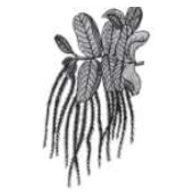The features seen in the gymnosperm Cycas include:
I. Coralloid roots
II. Unbranched stems
III. Pinnate persistent leaves
IV. Male cones and megasporophyllys borne on same plant
1. I and II only
2. I and IV only
3. I, II and III only
4. I, II, III, and IV
Both bryophytes and pteridophytes:
(1) are vascular cryptogams
(2) have a dominant sporophyte
(3) reproduce only sexually
(4) are haplo-diplontic
The life cycle pattern shown in the given diagram is not see in:

1. Chlamydomanas
2. Spirogyra
3. Volvox
4. Ectocarpus
The given diagram shows:

1. An alga that lacks flagellated cells
2. A liverwort
3. A heterosporous pteridophyte
4. A gymnosperm with non motile sperms
Identify the statement that most accurately describes the plant shown in the given figure:

1. This the male prothallus of Marchanita; A is antheridiophore and B is Gemma cup
2. This the female prothallus of Marchanita; A is archegoniophore and B is Gemma cup
3. This the male prothallus of Sphagnum; A is antheridiophore and B is Gemma cup
4. This the female prothallus of Sphagnum; A is archegoniophore and B is Gemma cup
The diploid sporphyte is represented by a dominant, independent, photoshynthetic, vascular plant body. It alternates with multicellular, saprophytic/autotrophic, independent but short-lived haploid gametophyte. This type of pattern is exhibited by
1. Bryophytes (Sphagnum, Polytrichum).
2.Pteridophytes (Selaginella, Lycopodium).
3. Most of the algal genera (Fucus, Chara, Polysiphonia).
4. Seed plants (gymnosperms and antiosperms).
The type of life-cycle in which there is no free-living sporophytes and the dominant, photosynthetic phase in such plants is the free-living gametophyte. We are talking about
1.Haplontic life cycle shown in Volvox and some species of Chlamydomonas.
2.Diplontic life cycle as shown in seed-bearing plants.
3.Haplo-diplontic life cycle as shown in bryophytes and pteridophytes.
4.Haplo-diplontic life cycle as shown in Kelps.
Read the following statements :
A. The male or female cones or strobili may be borne on same tree in Pinus.
B. In Cycas male cones and megasporophylls are borne on different trees.
C. Stem of Cycas is branched and of Pinus and Cedrus is unbranched.
D. In gymnosperms generally tap roots are found.
Select the correct statements.
1. A, B
2. A, B, D
3. A, B, C
4. C, D
Prothallus is
1. A structure in pteridophytes formed befor4e the thallus develops.
2. A sporophytic inconspicuous free living structure formed in pteridophytes.
3. A gametophytic inconspicuous free living structure formed in pteridophytes.
4. A gametophytic conspicuous structure formed after fertilization in pteridophytes.
Leafy stage develops from the secondary protonema as a
1. Apical bud
2. Axillary bud
3.Lateral bud
4. Meristem






